Today’s post is a guest post By Elinor Cohen from Just Me Company. You can read her bio at the bottom of this article.
What if I told you that you could have been earning more traffic and conversions today, had you started creating an analytics strategy only three months ago?
The truth is that you could have, but before I tell you how, I am going to share with you why.
Most of you are probably busy generating content and busy executing on your own business. I will assume that you have a blog, which probably supports your business. I will also assume that you write posts and try to generate as much engagement as possible through communicating with your audience. Finally, I will assume you have a following and might have successfully built at audience around the brand of YOU. But when was the last time you looked at the numbers? Have you clearly defined benchmarks and goals for generating traffic and acquiring new customers online? You would be surprised at the story that will unfold, once you start looking at your business analytics.
You may be selling your information and/or products, or you may be giving it away for free, but the bottom line is that you need to know if your efforts are generating the results you want.
You need to create benchmarks and then measure your success and failures online.

For bloggers there are two avenues, which I believe generate the highest return – without spending a lot of money. Organic Traffic (this includes organic search results and organic social media traffic) and Analytics.
You are already generating content, and that is one crucial aspect of SEO. The second avenue, and one that is usually overlooked by most business owners is analytics. How do you know whether your content is aligned with your customers? Simple. You implement the tools, measure, assess and optimize.
Below, I am going to share four must-have reports any blogger should use in Google Analytics for growing organic traffic and for growing a list.
Note: I will assume that you already have Google Analytics implemented on your blog. If you do not, it is fairly easy to set up, especially if you use WordPress. Click here in order to learn how to get your tracking code. Most platforms allow you to simply paste the unique code either into the theme’s template or through a plugin.
Recommendations:
- If you are using WordPress, I highly recommend downloading the Yoast SEO Plugin – it is the very best for all of your SEO Needs.
- Implement Google Search Console. This tool is a diagnostics tool, which tells you how your website is reflected to Google. Plus, it gives you a nice overview of any technical problems, which might hinder the search engines or your visitors from accessing content on your site. Finally, Google Analytics does not provide a lot of the keywords with which people land on your website, and Google Search Console does provide this information for you.
Once you are signed in to Google Analytics, you can open up another tab and just sign up for Search Console, and your account will be verified via Google Analytics.
And now…for the reports:
Set Up the Infrastructure to Increase Conversions
The first thing you need to do is to clearly define your website’s goals. What action do you want your visitors to take on your site? Once you decide on your goal, set it up with a ‘Thank you Page” to which visitors are directed after they take an action. If you have more than one goal, make sure to set up a unique thank you page for EACH goal.
For example, if you have an opt in, your unique thank you page could be: www.yourdomain.com/opt-in-thank-you. If you ALSO have a newsletter sign up, then your thank you page could be: www.yourdomain.com/newsletter-thank-you. It is important to measure the different transactions on your website separately. Too often, I see business owners using the same thank you page for different conversion points on their sites. When this happens, too much data gets mixed in together, making it difficult to draw conclusions on your traffic’s performance.
Go to the admin section of your site and choose your desired view. Then choose ‘goals’.

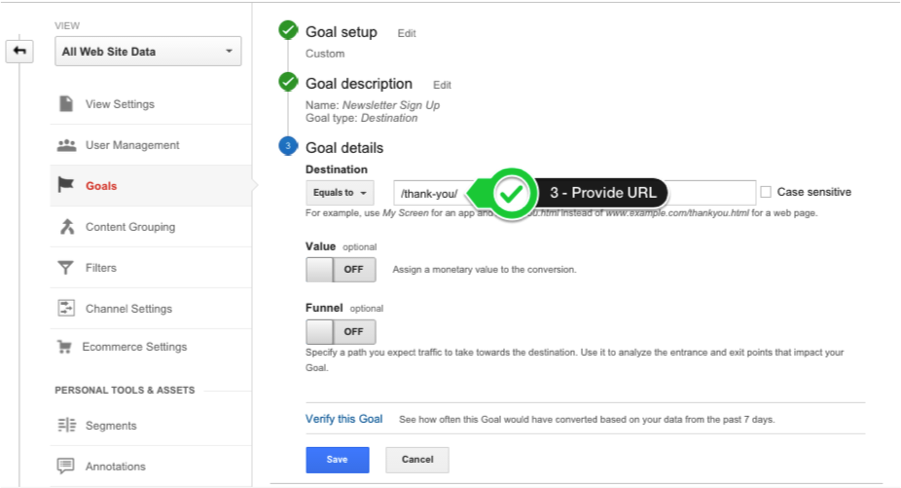
Setting up is pretty straight forward and intuitive. Once you have this set up, your reports will show you how many website visitors have converted.
Report #1 – Audience -> Overview
Overall Traffic
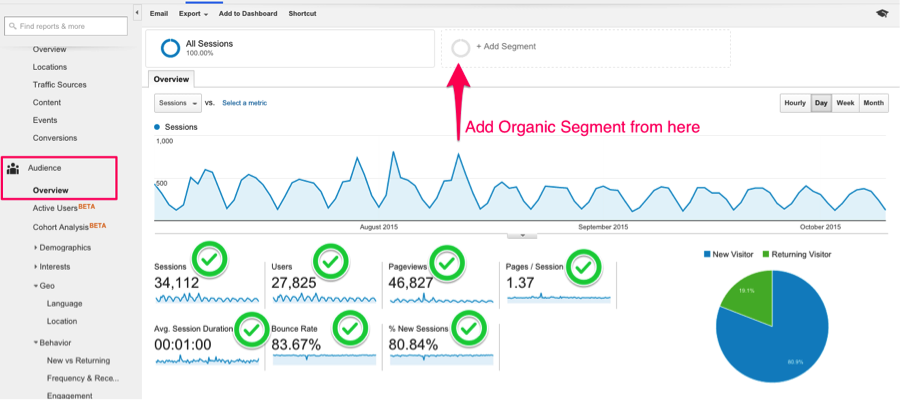
Set up a segment to compare overall traffic with organic traffic
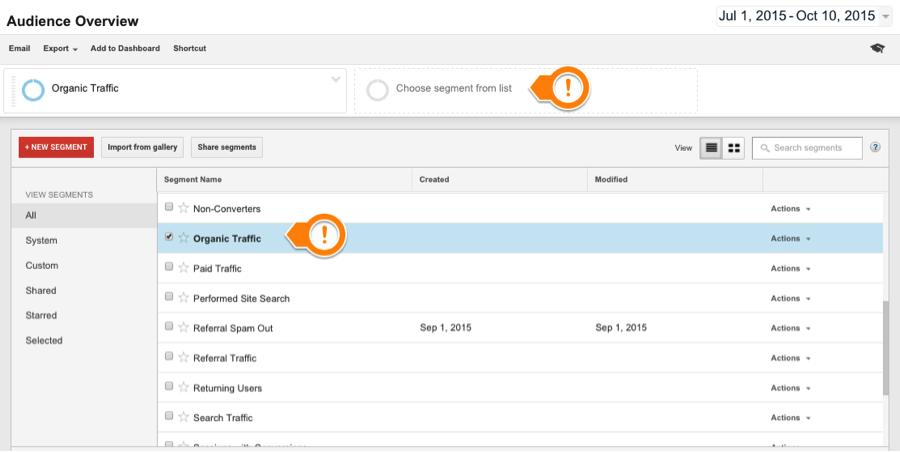
What it tells you:
- General Report about your overall website traffic vs. Organic Traffic. From this report you can then set your overall numerical benchmarks (noted with green checkmarks). You can compare your other channels’ metrics to these benchmarks. More on that below.
TIP: In order to get the most accurate metrics, you will need to analyze a statistically significant data set. Set your date range as far back as possible, in order for the data to be most relevant. I usually advise on looking 3 months back, if not more.
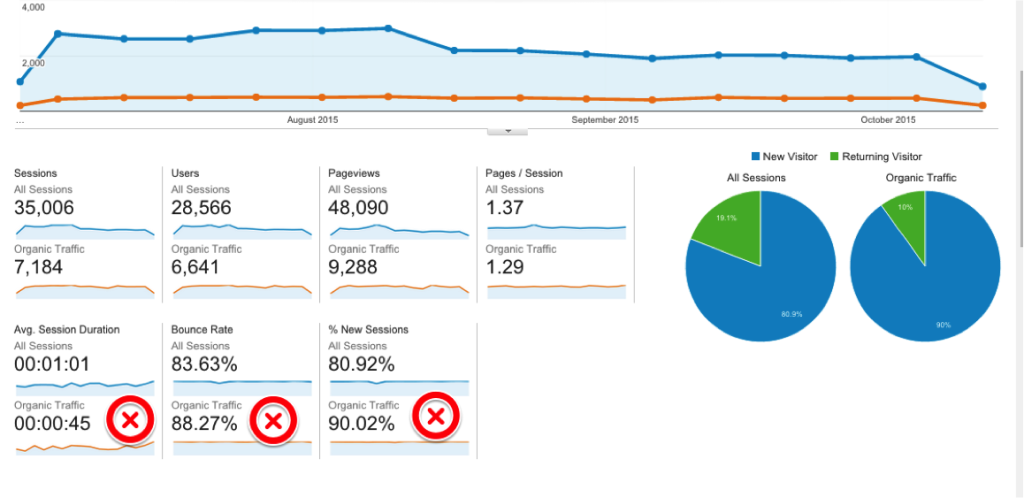
Report #2 – Audience -> Mobile -> Overview
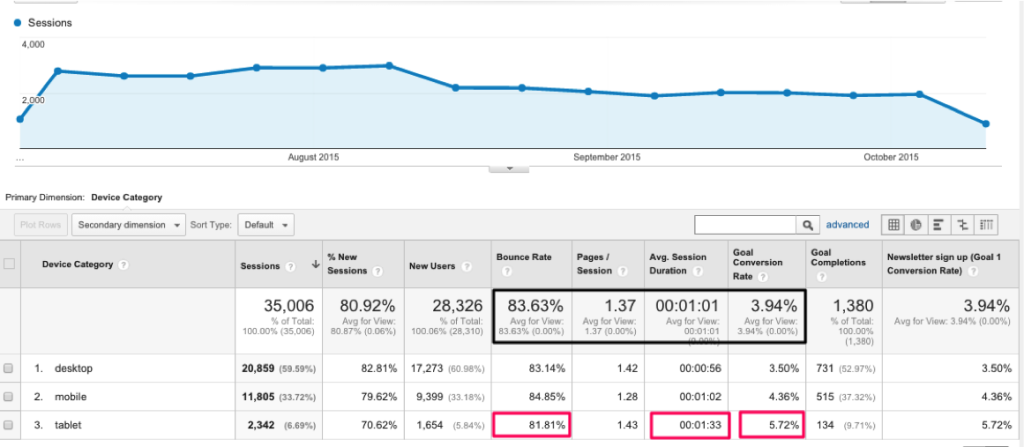
What it tells you:
Traffic is divided into 3 channels – Mobile, Desktop and Tablet. This report shows user behavior and engagement levels with your website from these 3 channels.
Note the average engagement levels of all 3 channels (noted by the black outline) and then note the metrics of tablet – they look promising – Bounce rate is lower than average, page / session is higher than average and the conversion rate is MUCH higher than average. We may want to dig into WHY the metrics are so much better from tablet users. Although the number of visits is much lower than desktop or mobile, perhaps increasing traffic from this source will help us increase engagement rates AND conversions.
The more you dig into your analytics, the more insight you will gain. What I mean by dig, is segmenting and filtering. If a lot of data is analyzed together, some really important information can get lost in the mix. Look at the example below. If you simply filter the report for tablet only and then add a secondary dimension of day of the week, you would gain a lot more insight. Note that on Wednesdays and Thursdays the conversion rate is highest. Maybe, on those days, you would want to schedule your new blog posts or share some new information on social media. This is how optimization begins, by testing hypothesizing, analyzing and optimizing again.
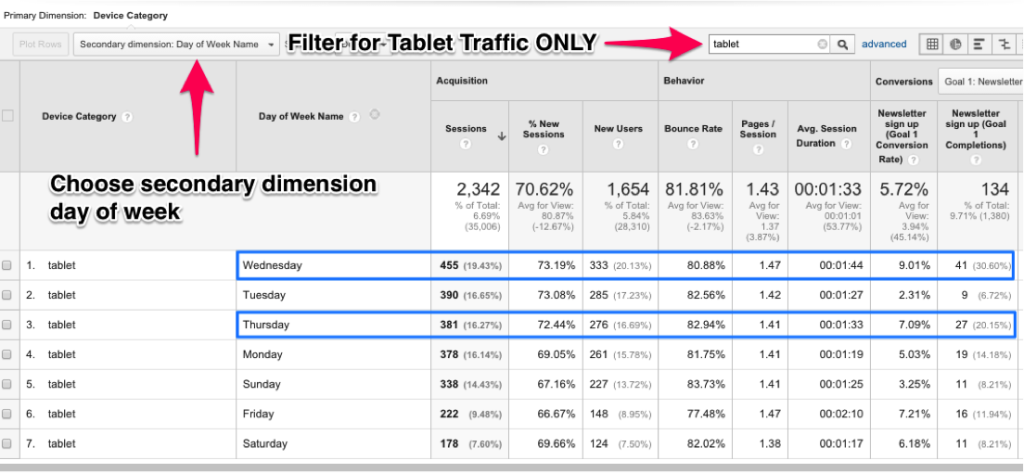
TIP: make sure the data you review does not include any special promotions that could have caused a spike in traffic or conversions – otherwise, you would be reaching false conclusions, because the spike in traffic from a specific promotion can skew the data in favor of higher conversions, average time on site, etc.
What if we took this same data, and looked for which sources are referring this traffic through tablet? This time, use secondary dimensions ‘source / medium’ and keep the ‘tablet’ filter on.
We can see that the Ladders and Forbes generate the most conversions, but notice that although the ladders referred less than 10% of the traffic (sessions) as Forbes did, the conversion rate is much higher (2% Forbes vs. 70% Ladders). Perhaps it is worthwhile to focus on publishing more content at the Ladders than Forbes, because tablet users seem to convert better through this medium. Note here, as well, that the bounce rate and average time on site for organic traffic is not aligned with the overall average metrics, and that the conversion rate is much lower – why is that? We will find out with the next report.
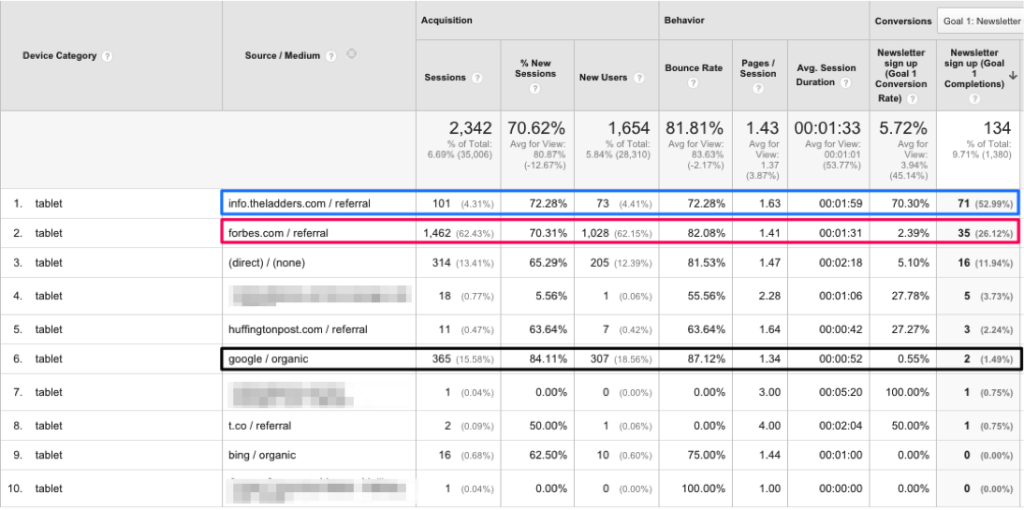
Organic Search Engine Traffic
Today, Google hides many of the keywords people use when they land on your site. That is because when someone is logged in to a Google product (gmail, app, etc.), Google will not pass this user’s information which includes the keywords used to conduct a search online – and think about it – most people are logged in to their gmail account while they are browsing and searching the web. Therefore, most of the keywords will show up as ‘not provided’ in your reports. In order to get the most insight possible, you will have to assess at least 2 reports.
Report #3A – Acquisition-> Search Engine Optimization->Queries
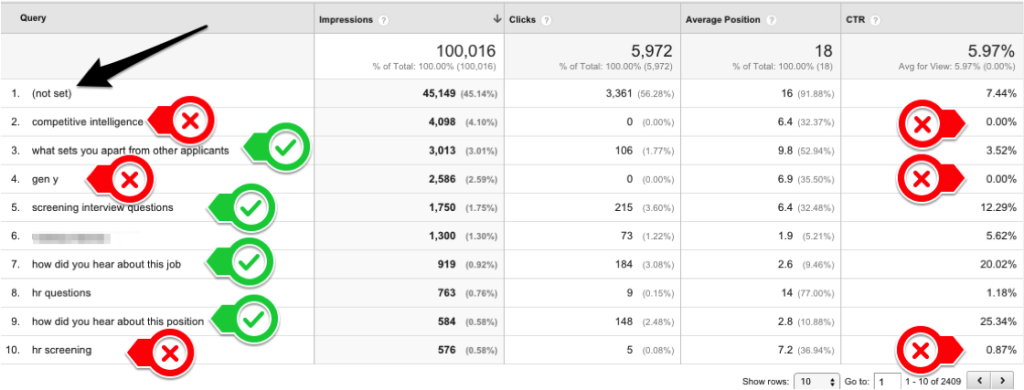
What it tells you:
You will probably never get rid of the ‘not set’ problem, and although there is a workaround for this, you still have to pay attention to the keywords that ARE referring traffic, their positions and click through rates to your website. In this example, for my career coaching client, note that the site appears for first page rankings for specific keywords that receive no clicks. In cases like these, it would make sense to probably reformat the content on the page that appears with this keyword and an overhaul of the page’s meta title and meta description, would probably generate higher click-through-rates as well. Note that a lot of the queries receiving higher click-through-rates are ones that are direct questions such as ‘how did you hear about this position’ and ‘what sets you apart from other applicants’. This is where great content strategy begins – you can see exactly for what potential customers are searching and which of your solutions(content) attracts them – offer more solutions like this and write titles to articles that are aligned with these search queries!
Report #3B – Acquisition-> Campaigns->Organic Keywords

Choose your goal and click on ‘not provided’ to dig deeper into the keywords that drive traffic but are not provided in this report. Choose ‘landing page’ as a secondary dimension.
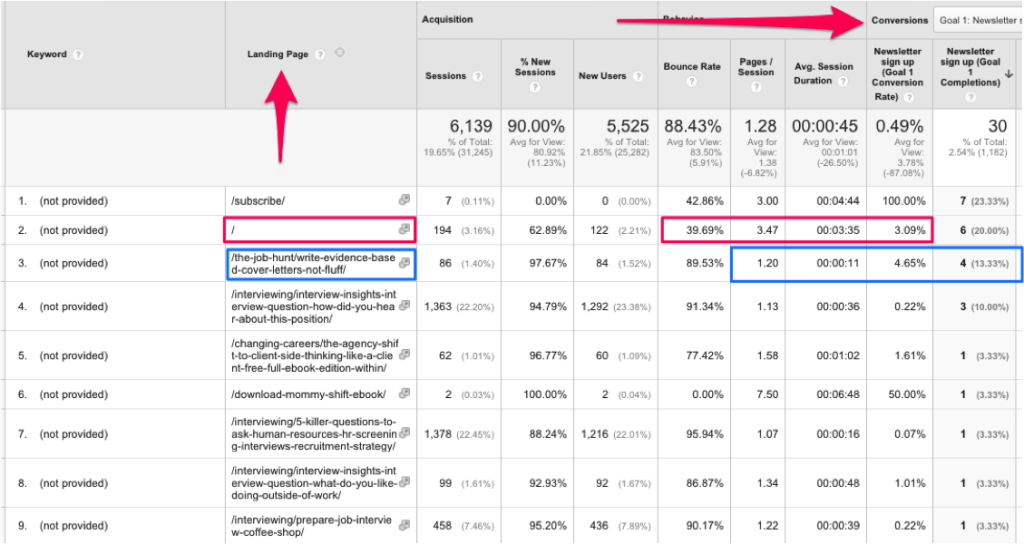
What it tells you:
On Which landing pages the ‘not provided’ visitor segment lands, visitor engagement levels – but most importantly, conversion rates.
Note that when someone lands on the homepage (outlined in pink) the bounce rate is way below average, the average pages per session are way above average and so is average time on site. The conversion rate is way higher than average of all other pages as well. This is true about the homepage, for 90% of the websites I have reviewed in my lifetime.
Secondly, note that one specific article (outlined in blue) has a relatively high conversion rate when compared with the amount of traffic it generated. Reviewing this page reveals that the writer has a few of things that can be optimized on the page:
1 – the date of the article is from 2012
2 – the article does not clearly lead visitors to signing up anywhere
3 – The title of the article should be more enticing and actionable (ie. #1 Guide to Writing a Killer Cover Letter)
Optimizing the above, could possibly increase sign ups.
Tip: It is best to change one thing at a time, analyze whether the change had any impact and only then implement another change.
Report #4 – Acquisition-> Social->Landing Pages
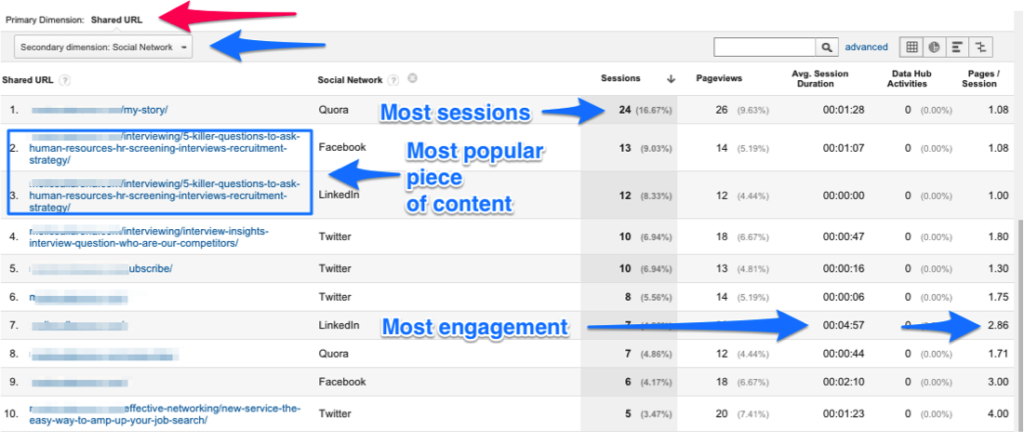
Choose ‘social network’ as a secondary dimension.
What it tells you:
The URLS that are being shared from your website in social media.
Dig deeper into which networks are sharing specific pieces of content and the engagement level this is bringing to your website. Use this report to optimize your time spent on various networks – maybe it’s time to focus on one over the other. Depending on your goals, maybe you would rather focus on the network that generates more engagement versus the one that generates more traffic.
Your analytics data will reveal a story about your website or blog. A lot of times we think we are sure a certain campaign was successful, when in fact it was not. This is why I have created a program called, the story behind the numbers. Every website has a story beyond the brand or offering. This story is usually told by its web analytics.
However, when you dig into your analytics data, you will find a lot of information, and it is best to stay focused. Too much information can get confusing and overwhelming. Start small, and focus your time and effort on the reports that will help you optimize your conversions and your marketing efforts.
Set realistic goals for your website or blog, and make sure to analyze your analytics data for at least 30 minutes per week, and make a week-on-week comparison to see that you are growing your traffic, engagement and conversions.
What story do the numbers tell about your website?
I’d love to hear if this article helped you achieve your numerical goals. If you have any questions or insight, feel free to email: elinor@justmecompany.com. You can also visit my website: www.justmecompany.com and download my 7 Action Items you Can Take Right Now to Get your Content Discovered by Google and start your SEO journey today.
About Elinor Cohen
 I’m Elinor Cohen, and I want to help manifest the business of YOU through search engine marketing and social media. Everyone searches in Google – Did you know that Google processes over 40,000 search queries every second?
I’m Elinor Cohen, and I want to help manifest the business of YOU through search engine marketing and social media. Everyone searches in Google – Did you know that Google processes over 40,000 search queries every second?
I will help your brand get the visibility and exposure it deserves around the web.
How? By making sure you show up in search results at the exact moment your customers are searching for the solution you offer. I’ve been doing online marketing since 2006, and I’m on a mission to share all of my knowledge, experience, mistakes and successes with soloprenuers, so that they can get more of the ‘right’ traffic without wasting any more time!
